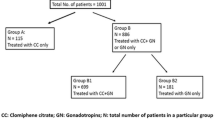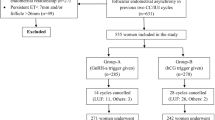Abstract
Purpose: To determine the optimal time for administration of human chorionic gonadotropin in clomiphene citrate induced intrauterine insemination cycles.
Methods: A retrospective analysis of 171 consecutive cycles was performed. An increase in luteinizing hormone level > 100% over the mean of the preceding two days was defined as luteinizing hormone surge. Human chorionic gonadotropin was given in preparation for intrauterine insemination based on the follicle size and estradiol level prior to surge in 85 cycles (Group A), with the spontaneous surge in 64 cycles (Group B) and not given in 22 cycles (Group C) due to high luteinizing hormone levels.
Results: The overall pregnancy rate per cycle was 18.1% (31/171), 15.2% (Group A), 20.3% (Group B) and 22.7% (Group C), (p > 0.50).
Conclusion: Although there may be physiological reasons to propose that timing the human chorionic gonadotropin to the luteinizing hormone surge will improve the success rate, they were not demonstrated.
Similar content being viewed by others
References
Allen NC, Herbert CM, Maxson WS, Rogers BJ, Diamond MP, Wentz AC: Intrauterine Insemination. A critical review. Fertil Steril 1985;44:569–580
Moghissi KS: Some reflections on intrauterine insemination. Fertil Steril 1986;46:13–15
Garcia JE, Jones GS, Wright GL: Prediction of the time of ovulation. Fertl Steril 1981;36:308–315
Vermesh M, Kletzky OA, Davajan V, Israel R: Monitoring techniques to predict and detect ovulation. Fertil Steril 1987;47:259–264
Martinez AR, Bernadus RE, Voorhorst FJ, Vermeiden JPW and Schoemaker J: A controlled study of human gonadotropin induced ovulation versus urinary lutenizing hormone surge for timing of intrauterine insemination. Hum. Reprod. 1991;6:1247–1251
Fuh KW, Wang X, Tai A, Wong I, Norman RJ: Intrauterine insemination: Effect of the temporal relationship between the luteinizing hormone surge, human chorionic gonadotropin administration and insemination on pregnancy rates. Hum Reprod. 1997;12:2162–2166
Seibel MM, Smith DM, Levesque L, Borten M, Taymor ML: The temporal relationship between the luteinizing hormone surge and human oocyte maturation. Am J Obstet Gynecol 1982;142(5):568–572
Testart J, Frydman R, Feinstein MC, Thebault A, Roger M, Scholler R: Interpretation of plasma luteinizing hormone assay for the collection of mature oocytes from women: Definition of a luteinizing hormone surge-initiating rise. Fertil Steril 1981;36:50–54
Testart J, Frydman R: Minimum time lapse between lutenizing hormone surge or human chorionic gonadotropin administration and follicular rupture. Fertil Steril 1982;37:50–53
Irons DW, Singh MM: Evaluation of transvaginal sonography combined with a urinary luteinizing hormone monitor in timing donor insemination. Hum Reprod 1994;9:1859–1862
Anderson AG, Als-Nielsen B, Hornnes PJ, et~al.: Time interval from human chorionic gonadotropin (HCG) injection to follicular rupture. Hum Reprod 1995;10:3202–3205
Lloyd R, Coulam CB: The accuracy of urinary luteinizing hormone testing in predicting ovulation. Am J Obstet Gynecol 1989;160:1370–1372
Arici A, Carr BR, Byrd W: Comparison of two LH monitoring methods in women undergoing intrauterine insemination. Proceedings of the 48th annual meeting of the American Fertility Society. San Antonio, TX. Nov 2–5. 1992;S70
Zreik TG, Garcia-Velasco JA, Habboosh MS, Olive DL, Arici A: Prospective, randomized, crossover study to evaluate the benefit of human chorionic gonadotropin-timed versus urinary luteinizing hormone-timed intrauterine inseminations in clomiphene citrate-stimulated treatment cycles. Fertil Steril 1999;71:6:1070–1074
Awonuga A, Govindhbai J: Is waiting for an endogenous luteinizing hormone surge and/or administration of human chorionic gonadotropin of benefit in intrauterine insemination? Hum Reprod 1999;14:1765–1770
Mitwally MF, Abdel-Razeq S, Casper RF: HCG administration on the day of endogenous LH surge is associated with improved outcome for timed intercourse and intrauterine insemination. Fertil Steril 2002:3:S7
Author information
Authors and Affiliations
Corresponding author
Rights and permissions
About this article
Cite this article
Madankumar, R., Tsang, J., Lesser, M.L. et al. Clomiphene citrate induced ovulation and intrauterine insemination: effect of timing of human chorionic gonadotropin injection in relation to the spontaneous LH surge on pregnancy rates. J Assist Reprod Genet 22, 155–159 (2005). https://doi.org/10.1007/s10815-005-4912-8
Received:
Accepted:
Issue Date:
DOI: https://doi.org/10.1007/s10815-005-4912-8




